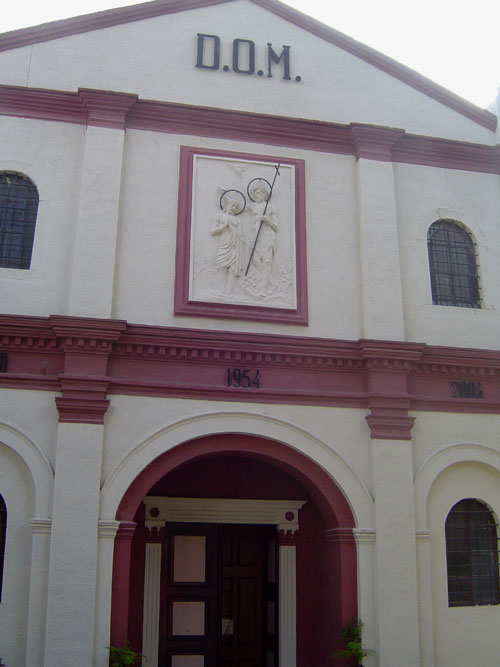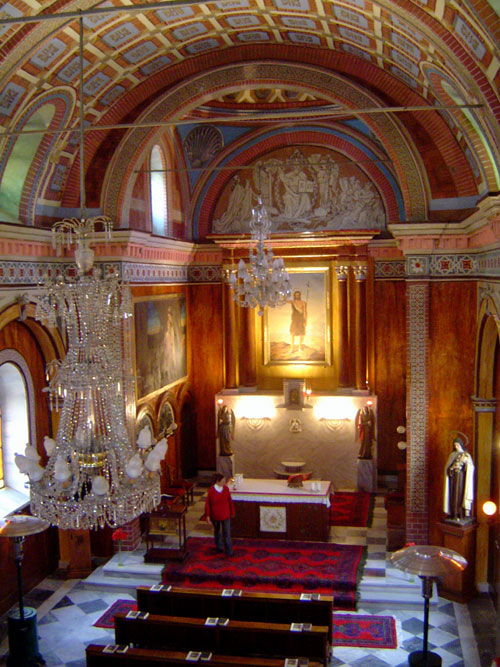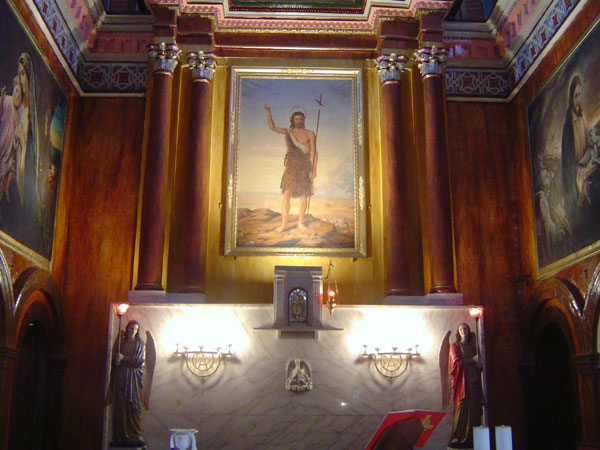 |
 |
 |
The
Catholic Church of Saint John Baptiste is located on street number 81
at Buca.
History of the Building
The church was founded in 1840. There isnít any information regarding the architect of the church. In 1954 the building was restored. The church was out of service between the years 1995 and 2000. The church re-opened after the latest renovation done in 2004.
Congragetion of the Church
In its heyday, the church served a large number of local Levantines. Nowadays, it is used both by Turkish Catholics and Levantines of Izmir. The number of the congregation is around thirty.
Building Analysis
a. Characteristics of the Plan
The church extends in the east-west direction. It has a rectangular plan with a single nave. Nave is covered with a barrel vault which is reinforced with eight columns. On each side, there are four columns embedded into walls. The columns are connected with semi-circular arches. In each arch, there is a large window through which daylight comes in. On each side of the roof, there are four oval windows over the mouldings. The elevated bema [rostrum] is located across the entrance and covered with a circular dome. There are two oval windows on each sides of the dome. A wooden staircase on the left side of the entrance leads to the upper gallery where the organ is situated. The belfry is located in the corner.
b. Characteristics of the Façade
The façade is simple. Three dates (1840, 1954, and 2004) on the moulding over the arched entrance represent the years of its foundation and restorations. Over the entrance on the second floor level stands the embossed design representing the Baptism of Jesus by St. John. There is a pediment with the initials D.O.M over this relief.
c. Interior Design and Decoration
The walls, the roof and the dome of the church are decorated with various geometric designs. There are painted shelves on the walls.
Two oil paintings are hung on each side of the nave. The painting on the left describes St. Petrus and St. Johannes. There are various biblical scenes depicted on the painting on the right. There is an oil painting of St. John hung over the altar in the chancel. The painting is asssumed to be drawn before the foundation of the church. There are large scale oil paintings of Jesus and Virgin Mary on both sides of the painting of St. John.
There are also various statues in the interior. On the left side stands the statues of Jesus and Virgin Mary (hançerli - bearing a dagger); and on the right side there are statues of the Virgin Mary and St. Antonio.
Another significant decorative element in the church is the wooden panels under the windows on both sides. The panels with the scenes from the Holy Bible are carved out by a member of the local Romano family.
The organ is placed into the upper gallery above the entrance. It is from the 19th century and is still in use today.
Information provided by researcher Onur Inal -2006
History of the Building
The church was founded in 1840. There isnít any information regarding the architect of the church. In 1954 the building was restored. The church was out of service between the years 1995 and 2000. The church re-opened after the latest renovation done in 2004.
Congragetion of the Church
In its heyday, the church served a large number of local Levantines. Nowadays, it is used both by Turkish Catholics and Levantines of Izmir. The number of the congregation is around thirty.
Building Analysis
a. Characteristics of the Plan
The church extends in the east-west direction. It has a rectangular plan with a single nave. Nave is covered with a barrel vault which is reinforced with eight columns. On each side, there are four columns embedded into walls. The columns are connected with semi-circular arches. In each arch, there is a large window through which daylight comes in. On each side of the roof, there are four oval windows over the mouldings. The elevated bema [rostrum] is located across the entrance and covered with a circular dome. There are two oval windows on each sides of the dome. A wooden staircase on the left side of the entrance leads to the upper gallery where the organ is situated. The belfry is located in the corner.
b. Characteristics of the Façade
The façade is simple. Three dates (1840, 1954, and 2004) on the moulding over the arched entrance represent the years of its foundation and restorations. Over the entrance on the second floor level stands the embossed design representing the Baptism of Jesus by St. John. There is a pediment with the initials D.O.M over this relief.
c. Interior Design and Decoration
The walls, the roof and the dome of the church are decorated with various geometric designs. There are painted shelves on the walls.
Two oil paintings are hung on each side of the nave. The painting on the left describes St. Petrus and St. Johannes. There are various biblical scenes depicted on the painting on the right. There is an oil painting of St. John hung over the altar in the chancel. The painting is asssumed to be drawn before the foundation of the church. There are large scale oil paintings of Jesus and Virgin Mary on both sides of the painting of St. John.
There are also various statues in the interior. On the left side stands the statues of Jesus and Virgin Mary (hançerli - bearing a dagger); and on the right side there are statues of the Virgin Mary and St. Antonio.
Another significant decorative element in the church is the wooden panels under the windows on both sides. The panels with the scenes from the Holy Bible are carved out by a member of the local Romano family.
The organ is placed into the upper gallery above the entrance. It is from the 19th century and is still in use today.
Information provided by researcher Onur Inal -2006